What does the internet mean to low-income Indians?
This analysis is based on the study titled 'TOWARDS DIGITAL INCLUSION, Barriers to internet access for economically-and socially-excluded urban communities', conducted by the Centre for Communication and Development Studies (CCDS), Pune.
Earlier this month, TRAI finally announced a principles-based regulation which bans Facebook Free Basics in India on the assumption that people without access to the internet do not want specialized differentially priced internet services. But in reality, there is hardly any empirical data to tell us how low-income users actually access the internet in their everyday lives. A study released in late 2015 hopes to change this scenario by enquiring into the internet usage patterns of economically and socially excluded urban communities.
Though the scope of the study is limited to some six low-income urban agglomerations in and around Pune and should not be used to generalize internet usage patterns by poor and marginalized people, it nevertheless uses a larger sample size and a more in-depth research methodology than the other few similar studies done in the past.
Here are 11 charts from the study which tell us how marginalized urban families access the internet (or don’t) and their perceptions, aspirations, and problems:
1. Most people think the internet is as basic as roti, kapda, makaan
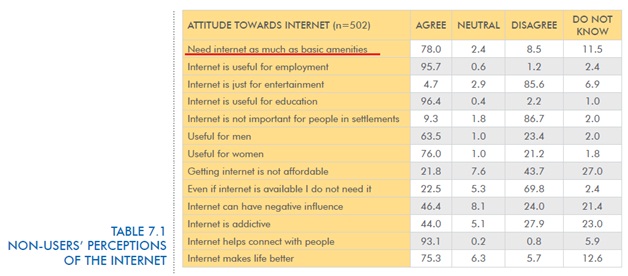
The study shows that 78% of the surveyed non-internet users and 80.1% of internet users consider the internet to be as basic as food, clothes and housing. This finding is corroborated by in-depth interviews and focus group studies within this sample. Interestingly, a slightly higher percentage of women (82.2%) feel that the internet is an essential amenity, when compared to men (79.4%) [see Table 7.4, page 115 of the Report].
The perceived benefits of the internet include building networks (51.2%), personalized entertainment (47.3%) and improving confidence and personality development (32.1%), but very few people feel that the internet provided them more knowledge about local issues and facilities(8.7%)[see Table 7.5]. This, the study concludes, might be due to the absence of local and hyper-local internet content that the surveyed users could find relevant to their lives.
2. Most people think their internet access quality is acceptable and affordable, but are confined to specific apps
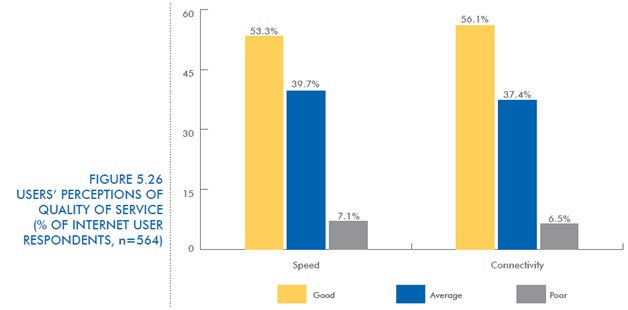

The study indicates a high level of user satisfaction with both the quality and affordability of internet services. However, the usage such satisfaction refers to is mostly confined to certain apps like Facebook, Whatsapp, YouTube, and simple search functions which become important as most of the internet access is derived exclusively through 2G services over mobile phones and due to high prices, there is very little demand for wired broadband services (see Report pages 86, 73, and 87 respectively).
This finding also stands in stark contrast to the 2015 Oxford Internet Institute-supported focus group study of low-income urban users in Delhi who were found to access a larger portion of the internet, including pirated content, and were highly sceptical of the quality and pricing of their internet services. The Pune study also warns that consumers probably rate internet affordability and service quality as good or average because “they have no benchmark for higher speeds and better connectivity” (see Report page 87). On the other hand, poor mobile internet network coverage also figured as a major barrier for internet access to users (48.8%) [See Figure 6.6, Report page 95].
3. Many non-users have not even heard the term “internet”
41% of the surveyed people who do not use the internet have also not heard of the “internet” yet. The remainder 59% who have heard of the internet are still unaware of its use and perceive it as something linked to computers and mobile phones [see page 89].
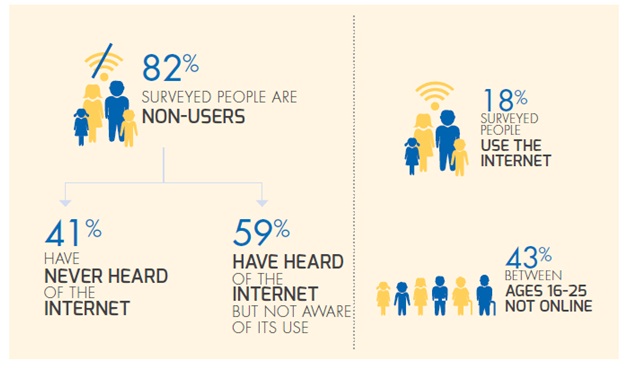
It is, however, encouraging to note that the younger non-users are at least more familiar with the term “internet” than older people. 66.1% of non-users in the 16-20 age group had heard of the internet as compared to just 32.8% in the 35+ age group [see Figure 6.1, Report page 90]. Occupation also seems to influence awareness. Of the non-users, 72.7% of students had heard of the internet as compared to only 29.4% of daily- wage workers [See Figure 6.2, Report page 90].
4. Not having ICT skills is the biggest barrier for a new internet user – above education, English, and cost
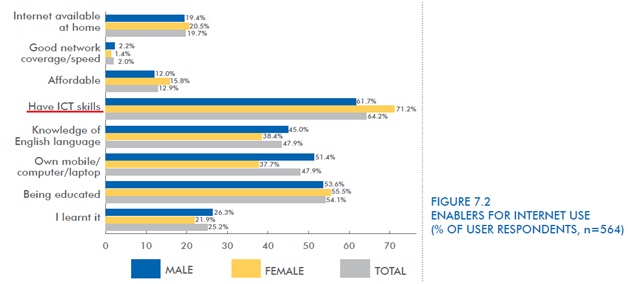
It is clear that internet users do not feel that better connectivity quality or lower service prices will seriously enable non-users to access the internet. The biggest barrier for new users, in fact, is the lack of ICT skills (64.2%). Women feel this lack more than men: 71.2% of women see it as a barrier as compared to 61.7% of men. Non-users also reported lack of education and skills as the biggest reason for their non-use of the internet (45.5%) [See Table 6.1, Report page 91].
This was followed by the barriers created by lack of education (54.1%) and lack of knowledge of English (47.9%).Internet affordability was seen as a barrier for a new user a fair bit down the ladder at 12.9%. Friends emerged as the biggest support network when it came to crossing these barriers (56.9%) – far above the next big support network viz., family members (10.5%) [see Table 7.6, Report page 117].
5. The younger and more educated are likelier to access the internet but not because of schools

The role of education in enabling internet access for a person becomes even more prominent when one notes the direct relationship between the level of education and internet access. Irrespective of age, if one is a graduate, one is almost twice as likely to use the internet as compared to someone who is educated just up to high school. Education thus emerges as a big factor responsible for the digital divide.
However, the prominence of one’s education level does seem to lessen if one is younger: of the secondary school educated, for example, those who are below 25 years of age are three more likely to access the internet than those who are 25 or above. However, it was found that only 38% of people learnt about the internet at school/college and even then they were rarely given hands-on or adequate exposure through formal training. Most users (47%) were introduced to the internet by their friends [see Figure 4.10, Report page 55].
6. Most people think the internet is useful for women yet women have much less access
Only 16% of the women surveyed were internet users as compared to 58% of men.
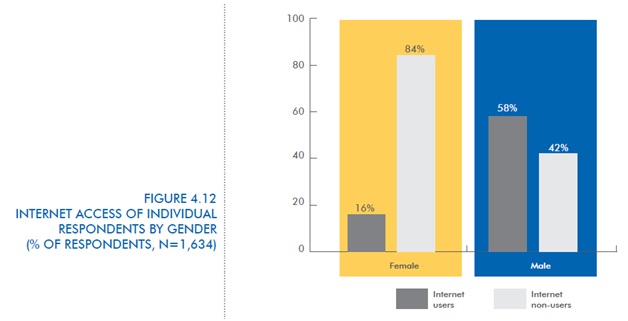
This is the case even though 76% of non-users think that the internet is useful for women specifically, more than for men (63.5%) [see Table 7.1, Report page 144]. But amongst users, this percentage is almost equal, with 65.2% of respondents saying the internet is useful for men, and 65.6% of respondents saying it is useful for women [see Table 7.3, Report page 145]. The study, however, concludes from this that the bias against women on the internet exists and special efforts need to be made to address the gender bias and apprehensions about women’s online safety [see Report page 144].
Part of the reason that women have extremely low internet access may be their lower ability to access mobile phones which the study finds is the way that most people access the internet. A 21 year old, 9th standard educated, unmarried female domestic worker who does not use the internet narrates, “I do not have a mobile phone. When I came to know about the internet, I felt I had to have it but I did not get permission to use the internet. My father does not like these things. He said, ‘People share anything and everything on Facebook’. My father doesn’t even allow my brothers to use it… He will give them permission once they finish their education… My parents think that girls do not need mobile phones. In our home, none of us women has ever used a mobile phone. Our parents say, “who are you going to call?” [See Box 6.1, Report page 91]
7. Caste and religion don’t seem to influence internet access considerably but occupation does

While socio-religious status does not seem to have a significant impact on people’s access to the internet, their occupation seems to play a major role:

Students are almost 9 times as likely to use the internet compared to daily wage workers. Similarly, 48% of the people employed in the service sector use the internet as compared to just 14% of the people not working. Nevertheless, a significant 52% of those in the service sector still qualify as internet non-users, pointing to a large portion of even the relatively privileged population not being connected to the internet. Additionally, socio-religious factors like caste are likely to influence people’s occupations as well, and this hidden correlation between caste, religion and occupation needs to be taken into account while assessing these figures.
8. Most people use the internet for entertainment, followed by social networking

Entertainment is the most popular purpose for which people use the internet, followed by social networking. But education levels seem to play a role here again – the more educated one is, the likelier one is to use the internet for learning and job hunts. Therefore 62% of those who have studied at least till graduate level use the internet for this purpose compared to just 29% of those educated up to high school. More men than women seem to use the internet for entertainment (84.4% v. 66.4%) and social networking (82.3% v. 58.2%). But a larger proportion of women use the internet for learning and employment opportunities (55.5% v. 44.3%) [see Figure 5.7, Report page 71].
9. Very few users feel the internet is helpful in accessing e-governance schemes

If the government thought that the internet is enabling more inclusive governance through its ability to reach the marginalized, it is wrong. Only a miniscule 8% of the surveyed internet users felt that the internet is useful in finding out about government benefits and services such as Aadhar cards, voter cards, and policies and schemes for the economically and socially excluded. Based on this finding the Report suggests that the “government at all levels – local, state and central – cannot expectits Digital India and e-governance initiatives to simply trickle down to excluded communities”(see Report page 115). It seems that the internet is not really helping in better governance as much as it has been hoped.
10. Those who are not connected want to be connected

The heartening finding is that a large portion of people who are not connected now want to use the internet. 72.9% of non-users want to be connected via the internet in the near future, while 11.8% are unsure, which leaves only 15.3% of the surveyed non-user population as actually uninterested in using the internet. 75.3% of this non-user population thought that the internet has the ability to improve their lives(see Table 7.1, Report page 114). As the Report concludes, this is good news for bridging the digital divide as people seem genuinely interested in the internet (see Report page 114). But as pointed out before, factors like the lack of ICT skills, education and gender disparities still need to be addressed if this gap is to be covered.
11. Nearly everyone wants public internet

A staggering 97% of those surveyed (both internet and non-users) want a public internet facility, with the most preferred access point being the corporator’s office, anganwadi or community hall. This finding, however, stands in stark contrast to a 2014 ethnographic study of rural Rajasthan where, in spite of the availability of a free and high speed optic fibre-based public internet service at village telecentres, villagers still preferred to access the internet through paid data packs on their mobile devices.
This latter study notes, “The telecentre is located within the village panchayat building where not everyone feels welcome. While on paper it is equally accessible to all villagers, in practice more often than not, only a few – students enrolled in the digital literacy class, friends and relatives of the telecentre agent - manage to get access.” Such contrasts suggest that the manner in which people want to get internet access might vary across the country and vary from urban to rural. Therefore each study should be contextualized within its specific conditions and neither can be justifiably cited yet to argue for a particular direction in law and policymaking for internet access, digital divide and net neutrality for the entire country.
Smarika Kumar is a legal researcher who was until recently with the Alternative Law Forum, Bangalore.







